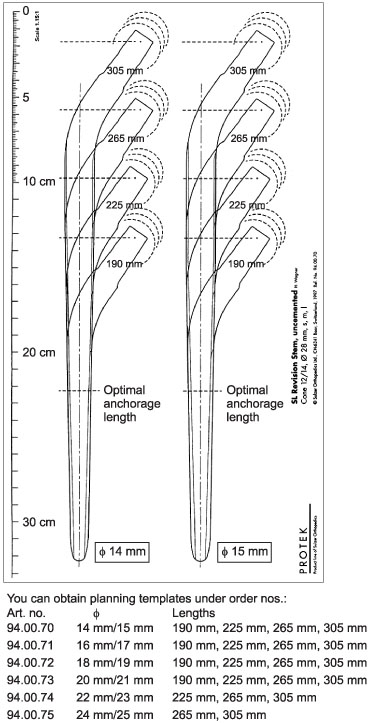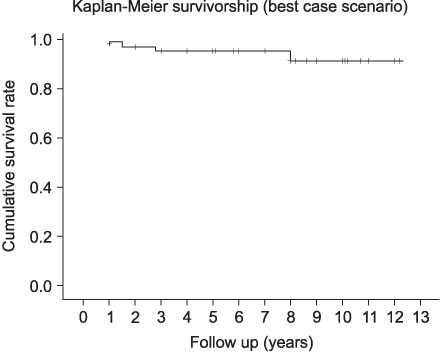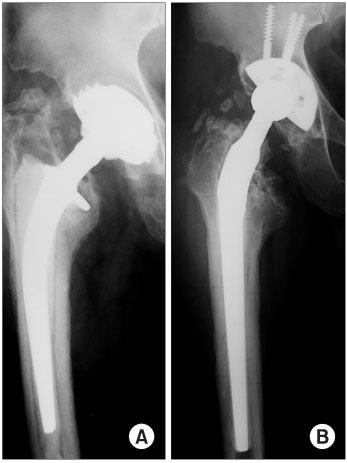J Korean Orthop Assoc.
2007 Apr;42(2):241-248. 10.4055/jkoa.2007.42.2.241.
Femoral Revision with the Wagner SL Revision Stem
- Affiliations
-
- 1Department of Orthopedic Surgery, Yonsei University College of Medicine, Seoul, Korea. cdhan@yumc.yonsei.ac.kr
- KMID: 854594
- DOI: http://doi.org/10.4055/jkoa.2007.42.2.241
Abstract
- PURPOSE: To evaluate the results of revision total hip arthroplasty using a Wagner SL revision stem. MATERIALS AND METHODS: This study reviewed 56 revisions of the femoral component performed using a Wagner stem in 55 patients between 1992 and 2001. The mean age of the patients at the time of the revision was 50 years. The mean follow up duration was 8.4 years (range, 5 to 12.5 years). The indication for revision was aseptic loosening in fifty-two hips, septic loosening in two and periprosthetic fractures in two. The pre-revisional femoral defects were classified according to the Paprosky classification system. A clinical evaluation and radiological assessment were performed. RESULTS: The mean Harris hip score improved from 47 points preoperatively to 87 points at the latest follow-up. There were 5, 20, 22 and 9 hips of type I, II, IIIA and IIIB according to the Paprosky classification system. Fifty two hips (93%) showed stable stems at the latest follow-up radiographs. The mean vertical subsidence of the stem was 6.2 mm (range, 0 to 21 mm). Severe progressive vertical subsidence in three hips and an infection in one occurred requiring repeat revision. CONCLUSION: For severe proximal femoral bone loss, the conical femoral revision stem with a fully grit-blasted surface produced satisfactory results with distal press-fit fixation. We can expect a decrease in the rate of mechanical failure rate of the stem by reducing the subsidence derived from the stem design itself.
Keyword
Figure
Cited by 1 articles
-
Revision Total Hip Arthroplasty Using a Wagner Revision Stem
Yee-Suk Kim, Chang-Min Cho, Kyu-Tae Hwang, Young-Ho Kim, Il-Yong Choi
J Korean Hip Soc. 2010;22(2):137-142. doi: 10.5371/jkhs.2010.22.2.137.
Reference
-
1. Bohm P, Bischel O. Femoral revision with the Wagner SL revision stem : evaluation of one hundred and twenty-nine revisions followed for a mean of 4.8 Years. J Bone Joint Surg Am. 2001. 83:1023–1031.2. Brooker AF, Bowerman JW, Robinson RA, Riley LH Jr. Ectopic ossification following total hip arthroplasty. Incidence and a method of classification. J Bone Joint Surg Am. 1973. 55:1629–1632.3. Della Valle CJ, Paprosky WG. Classification and an algorithmic approach to the reconstruction of femoral deficiency in revision total hip arthroplasty. J Bone Joint Surg Am. 2003. 85:1–6.
Article4. Engelbrecht DJ, Weber FA, Sweet MB, Jakim I. Long-term results of revision total hip arthroplasty. J Bone Joint Surg Br. 1990. 72:41–45.
Article5. Engh CA, Massin P, Suthers KE. Roentgenographic assessment of the biologic fixation of porous-surfaced femoral components. Clin Orthop Relat Res. 1990. 257:107–128.
Article6. Gie GA, Linder L, Ling RS, Simon JP, Sloof TJ, Timperley AJ. Impacted cancellous allografts and cement for revision total hip arthroplasty. J Bone Joint Surg Br. 1993. 75:14–21.
Article7. Gorab RS, Covino BM, Borden LS. The rationale for cementless revision total hip replacement with contemporary technology. Orthop Clin North Am. 1993. 24:627–633.
Article8. Gross AE, Allan DG, Lavoie GJ, Oakeshott RD. Revision arthroplasty of the proximal femur using allograft bone. Orthop Clin North Am. 1993. 24:705–715.
Article9. Gruen TA, McNeice GM, Amstutz HC. "Mode of failure" of cemented stem-type femoral components: a radiographic analysis of loosening. Clin Orthop Relat Res. 1979. 141:17–27.10. Grunig R, Morscher E, Ochsner PE. Three- to 7-year results with the uncemented SL femoral revision prosthesis. Arch Orthop Trauma Surg. 1997. 116:187–197.
Article11. Han HJ, Kim SS, Choi SH. The use of the Wagner cementless revision stem in revision total hip arthroplasty. J Korean Hip Soc. 1999. 11:161–167.12. Hartwig CH, Bohm P, Czech U, Reize P, Kusswetter W. The Wagner revision stem in alloarthroplasty of the hip. Arch Orthop Trauma Surg. 1996. 115:5–9.
Article13. Kavanagh BF, Ilstrup DM, Fitzgerald RH Jr. Revision total hip arthroplasty. J Bone Joint Surg Am. 1985. 67:517–526.
Article14. Ko PS, Lam JJ, Tio MK, Lee OB, Ip FK. Distal fixation with Wagner revision stem in treating Vancouver type B2 periprosthetic femur fractures in geriatric patients. J Arthroplasty. 2003. 18:446–452.
Article15. Kolstad K, Adalberth G, Mallmin H, Milbrink J, Sahlstedt B. The Wagner revision stem for severe osteolysis. 31 hips followed for 1.5-5 years. Acta Orthop Scand. 1996. 67:541–544.
Article16. Krishnamurthy AB, MacDonald SJ, Paprosky WG. 5- to 13-year follow-up study on cementless femoral components in revision surgery. J Arthroplasty. 1997. 12:839–847.
Article17. Lawrence JM, Engh CA, Macalino GE, Lauro GR. Outcome of revision hip arthroplasty done without cement. J Bone Joint Surg Am. 1994. 76:965–973.
Article18. Lyu SR. Use of Wagner cementless self-locking stems for massive bone loss in hip arthroplasty. J Orthop Surg. 2003. 11:43–47.
Article19. Moreland JR, Bernstein ML. Femoral revision hip arthroplasty with uncemented, porous-coated stems. Clin Orthop Relat Res. 1995. 319:141–150.
Article20. Paprosky WG, Greidanus NV, Antoniou J. Minimum 10-year-results of extensively porous-coated stems in revision hip arthroplasty. Clin Orthop Relat Res. 1999. 369:230–242.
Article21. Roberson JR. Proximal femoral bone loss after total hip arthroplasty. Orthop Clin North Am. 1992. 23:291–302.
Article22. Stoffelen DV, Broos PL. The use of the Wagner revision prosthesis in complex (post) traumatic conditions of the hip. Acta Orthop Belg. 1995. 61:135–139.23. Wagner H. Revision prosthesis for the hip joint in severe bone loss. Orthopade. 1987. 16:295–300.24. Wagner H. A revision prosthesis for the hip joint. Orthopade. 1989. 18:438–453.25. Wagner H. Revision of femoral stem with important loss of bone stock. Post graduate lectures of the first European Federation of National Associations of Orthopaedics and Traumatology (EFORT). 1993. Paris: Masson;64–74.26. Wagner H, Wagner M. Hip prosthesis revision with the non-cemented femoral revision stem-10 years experience. Med Orth Tech. 1997. 117:138–148.
- Full Text Links
- Actions
-
Cited
- CITED
-
- Close
- Share
- Similar articles
-
- Revision Total Hip Arthroplasty Using a Wagner Revision Stem
- Revision Total Hip Replacement using a Cementless Wagner SL Femoral Stem
- Revision of Total Hip Arthroplasty Using Wagner Femoral Revision Stem
- 5-12 Year Results of Femoral Revision Total Hip Arthroplasty using the Wagner Revision Stem
- Revision of the Femoral Stem




